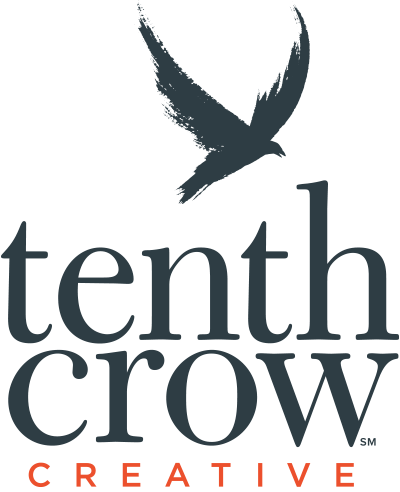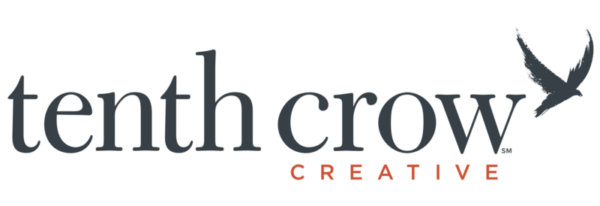
At Tenth Crow Creative, we work with a variety of organizations that address social determinants of health (SDOH) in their communities. SDOH are conditions in the environments in which people are born, live, learn, work, play, worship, and age that affect a wide range of health, functioning, and quality-of-life outcomes and risks—things like housing instability, food insecurity, mental and physical health access, and transportation.¹ Because health and wellness are largely affected by SDOH,² we know that organizations that work to address SDOH, such as healthcare, behavioral health, affordable housing, elder care, food shelves and other community support organizations are vital to individual and community health.
For today’s SDOH organizations, having a strong, resonant and impactful brand identity is more important than ever. Many, if not most, of these organizations are dependent to some degree on government funding and, in the time of COVID-19, there will be even more competition for available dollars. So, a strong brand identity that raises your organization above the clutter is critical.
As was already the case, competition for the time and attention of your target audiences is growing increasingly fierce. We each endure a barrage of messages, ads, appeals and offers from for-profit and non-profit businesses and organizations every day. They compete for our attention on our web browsers, in our inboxes and social media feeds—and that’s only counting the ones that are specifically targeted to us. When your message is just one of the many voices fighting to be heard, the difference between making an immediate impact and being ignored comes down to one thing, the strength of your organization’s brand identity.
If you are someone involved in planning, directing or implementing your organization’s marketing or communication goals, you’re probably concerned with one (or all) of the following things:
A strong, effective SDOH Organization brand identity can—and will—support all of these things.
Elements needed.
For an effective brand identity, you need the following elements:
Clear messaging.
Clear, defined messaging that quickly explains the mission, purpose and impact of your organization is at the heart of an effective brand identity. It serves as the rallying point for your employees and leadership and is the axis around which the rest of the brand rotates, with all efforts supporting that shared purpose and vision. A unique message can also serve as a differentiating factor. For example, your organization may support a cause that’s shared by many other organizations, but your approach to delivering the service is unique. Your messaging should highlight what it is that sets you apart from the others in your field—and why you’re best for accomplishing the mission.
Strong visual presence.
The importance of a strong visual presence comes down to consistency and recognizability (in addition to conveying character). There is nothing worse than a brand identity where visual communication is scattered, with each piece of digital or printed collateral presenting a totally different personality. With every interaction that your audience has with your organization, they build an impression of who you are and what you stand for (this impression is the essence of your brand). Establish (and enforce) a strong and clear visual language via color, font and design guidelines so that each of these audience interactions reinforces a sense of excellence, professionalism, and clarity. Also, it’s impossible to understate the importance of robust and strategic graphic design in getting your brand identity to stand out and stay visible. For an example of this strategy in action, check out the brand identity we created for Citizen Advocates, a behavioral health organization providing mental health, addiction recovery, and intellectual and developmental disabilities services throughout the North Country of New York.
High-impact communication.
We all know how underwhelming it can be to receive a postcard-sized piece of mail from an organization and, after reading it, have no idea what you’re supposed to do next. High-impact communication is all about writing and designing your communication pieces around a specific conversion, or in other words, an action that you want the audience to take. For example, SDOH organizations often have their homepage designed for donation conversions, or newsletter signups, while direct mail pieces may be designed to garner RSVPs for an upcoming event. Additionally, attaching a goal to each piece makes it much easier to track the results of your efforts. Efficient and effective communication is also aided by a consistent tone of voice that reinforces your brand identity’s defined character.
Getting everyone involved in bringing the brand identity to life.
An organization’s brand identity is its strongest when everyone helps to bring it to life. It is not only the responsibility of the marketing or communications department to maintain the brand identity—it’s every other department’s job too. Each employee is a representative of the brand, and each interaction they have with the outside world while working on behalf of the organization is an opportunity to reinforce your organization’s mission, purpose and values.
Visible expertise.
Demonstrating your organization’s expertise in your area of focus is a powerful way to differentiate yourself and to establish your brand’s credibility. There can be a bit of a humility hurdle to jump when it comes to touting your own knowledge, but it’s important to realize that in addition to being instrumental to providing quality and effective services, expertise has the power to generate interest and trust when marketed strategically. An organization’s collective expertise, or that of a particular leader with a lot of experience, can be published online, turned into informative videos, or channeled into speaking engagements and events. Visible expertise contributes to a strong brand identity because it reinforces your credibility, positions you and your organization as a helpful resource and leader in the space, and expands your online reach.
Okay, but how do I create these elements for our brand identity?
Of course, I’m going to say this but, with as much objectivity as I can muster, your best bet is to work with a creative agency to develop your brand identity. Having someone from the outside looking in is critically important because (1) ultimately, a brand is simply the perceptions that other people have of your company and, because you are pickled in it, an agency is in a better position to evaluate those perceptions, and (2) this exploration can be hard and is time-consuming work that very well may get put off or inadequately addressed if done internally.
That said, it certainly is possible to identify and build your own brand identity but there should be a clear process developed and adequate time devoted to those who are assigned the task.
As with most things, identifying and building a brand identity isn’t rocket science. There may be a bit of intuitive magic to it but the process itself is relatively straightforward. Typically, our process involves:
Discovery – You can’t build a brand identity without understanding. While the extent of our discovery process varies depending on the nature of the client and the budget involved, it typically includes:
Brand Assessment – Taking what we’ve learned, we then create a document that we call a brand assessment that sets forth:
Of course, this is not done in a vacuum. We collaborate with you to make sure the assessment is accurate and consistent with your mission.
Distillation – This is where critical thinking and analysis meet creativity—or collide is more like it. This is where the magic happens. This is one of the reasons why you hire an agency. Pulling from the brand assessment and all of the information that supports it, we develop your:
And, from there we create your brand identity, which consists of:
Again, this is not done in a vacuum and involves extensive collaboration and input from you.
Through this exercise, the visual, spoken and written components of the brand identity become focused and reflective of the organization’s identity.
Adoption – Once we have these elements in place, we incorporate them into a brand guide, which as its name implies, serves as a guide to you and your organization as you move forward, helping to ensure that the brand identity maintains its strength and is not diluted over time. Also, during this phase, we conduct an internal brand identity rollout with your staff. Not only is this to educate staff about the new brand identity, but it also is meant to get staff excited and invigorated to embrace the brand—living it in everything they do. After all, it’s your employees who should be your strongest brand ambassadors.
Execution – So you have this brand guide, now what? This is the phase where we take the steps necessary to launch the brand identity externally. First, we develop a communications plan that identifies the various platforms to utilize for launch (i.e. those platforms used by your target audiences), the creative assets needed for the launch campaign and the ongoing marketing collateral your organization will need moving forward. In accordance with the communications plan, we then build out the creative assets and marketing collateral and implement the plan.
If you’re responsible for the health of your organization’s brand and feel that there’s work to be done to improve its brand identity—but you’re not sure where to begin—please get in touch. We can talk through your needs, priorities, and options for strengthening your brand identity.
Tenth Crow Creative is a brand marketing agency that creates, aligns, and promotes the external and internal messaging for organizations that support living healthier lives. Through insightful branding and compelling marketing campaigns, we help these essential organizations find their identities and effectively communicate to their stakeholders so they can fulfill their missions.
¹Social Determinants of Health
²Addressing the Real Implications of Social Determinants of Health

50 Lakeside Ave #H4
Burlington, Vermont 05401
802.391.9854
info@tenthcrowcreative.com

Posted By
Tenth Crow Creative
Categories
Branding, Social Determinants of Health